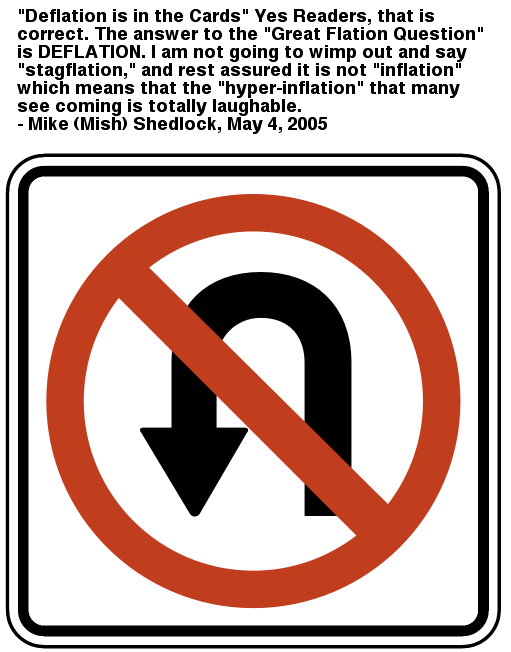 |
by Eric Janszen
Inflation versus deflation debate keeps contrarian economics and finance pundits pontificating for ten fabulous years. Fed flushes banks with funds and a fresh flurry of articles fills the blogosphere. Finally, the "financial economy" enters.
I’m glad to see the term “financial economy” enter the vocabulary in this inflation versus deflation discussion with a recent note I got from Aaron Krowne. We didn’t pick up on the idea until Bill Gross started talking about it in The Last Vigilante (Gross, Feb. 2004):
“I would argue the most critical reformation in the past twenty years since Volcker’s prime has been the transition of the U.S. from a manufacturing/to a service/to a finance-based economy within the span of two decades. Purists will perhaps rightly quarrel with the chronology or maybe even the logic, but it seems to me in any case that the critical difference between then and now is that profits and employment – 2/3 of the critical constituents that a Fed Vigilante must protect (inflation being the third) – are now primarily a function of the amount of debt/leverage and its cost.”
Perhaps Gross had been reading Kevin Phillips, who started writing about the Finance, Insurance, and Real Estate (FIRE) Economy in 2002. From Wikipedia:Phillips uses the term “financialization” to describe how the U.S. economy has been radically restructured from a focus on production, manufacturing and wages, to a focus on speculation, debt, and profits. Since the 1980s, Phillips argues in American Theocracy,
"...the underlying Washington strategy… was less to give ordinary Americans direct sums than to create a low-interest-rate boom in real estate, thereby raising the percentage of American home ownership, ballooning the prices of homes, and allowing householders to take out some of that increase through low-cost refinancing. This triple play created new wealth to take the place of that destroyed in the 2000-2002 stock-market crash and simultaneously raised consumer confidence.
"Nothing similar had ever been engineered before. Instead of a recovery orchestrated by Congress and the White House and aimed at the middle- and bottom-income segments, this one was directed by an appointed central banker, a man whose principal responsibility was to the banking system. His relief, targeted on financial assets and real estate, was principally achieved by monetary stimulus. This in itself confirmed the massive realignment of preferences and priorities within the American system….
"Likewise huge and indisputable but almost never discussed were the powerful political economics lurking behind the stimulus: the massive rate-cut-driven post-2000 bailout of the FIRE sector, with its ever-climbing share of GDP and proximity to power. No longer would Washington concentrate stimulus on wages or public-works employment. The Fed's policies, however shrewd, were not rooted in an abstraction of the national interest but in pursuit of its statutory mandate to protect the U.S. banking and payments system, now inseparable from the broadly defined financial-services sector."
"Nothing similar had ever been engineered before. Instead of a recovery orchestrated by Congress and the White House and aimed at the middle- and bottom-income segments, this one was directed by an appointed central banker, a man whose principal responsibility was to the banking system. His relief, targeted on financial assets and real estate, was principally achieved by monetary stimulus. This in itself confirmed the massive realignment of preferences and priorities within the American system….
"Likewise huge and indisputable but almost never discussed were the powerful political economics lurking behind the stimulus: the massive rate-cut-driven post-2000 bailout of the FIRE sector, with its ever-climbing share of GDP and proximity to power. No longer would Washington concentrate stimulus on wages or public-works employment. The Fed's policies, however shrewd, were not rooted in an abstraction of the national interest but in pursuit of its statutory mandate to protect the U.S. banking and payments system, now inseparable from the broadly defined financial-services sector."
"The exponential growth of savings and debt takes the form mainly of loans to finance the purchase of real estate, stocks and bonds. These loans extract interest and amortization charges that divert revenue away from being spent on goods and services. The payment of debt service by the economy’s non-financial sectors interrupts the circular flow that Say’s Law postulates to exist between producers and consumers."
Well, Hudson is an economist and he writes like one. It's tough going for a lay reader, but worth it if you're trying to understand how our economy really works. His most approachable piece is an update to Friedrich A. Hayek's Road to Serfdom titled New Road to Serfdom. Hudson explains that the FIRE Economy is turning us all into debt slaves.Reading Hudson and Phillips is like taking the Red Pill. If you're not familiar with the movie The Matrix, the Red Pill is the one you take if you want to see past the surface illusion of the made-up world. Once you read Hudson and Phillips, no matter whether you agree with their solutions, it's hard to go back to seeing the economy as anything but two distinct economies: the great, big FIRE Economy and the itty bitty Production/Consumption Economy.
Inflation versus deflation: Red Pill view
For readers who've taken the Red Pill, the inflation vs deflation discussion needs to be put into the context of the FIRE and P/C Economies.
- Fed monetary policy for the FIRE Economy is distinct from monetary policy for the P/C Economy.
- Continuous asset price inflation is the objective of FIRE Economy monetary policy. Within the residential real estate market these policies have been effective until recently. They continue to work in the commercial real estate market, but perhaps for not much longer, starting with retail.
- Low wage inflation is the primary objective of P/C Economy monetary and government policy because wages are the mechanism for transmission of inflation into the inflation cycle. Wage inflation can be managed via immigration policy, outsourcing policy to affect global wage arbitrage, and so on.
- Payments within the FIRE Economy may be 100 or more times the total payments within the P/C Economy.
- This does not mean that small changes in FIRE Economy growth have an out-sized impact on the P/C Economy. The opposite is true. The FIRE Economy is a 400 HP car engine in your car and the P/C economy as the 1/10th HP heater that warms your car with the waste heat from the engine.
- Asset price inflation and deflation occurs within the FIRE Economy without a direct impact on wages and goods prices within the P/C Economy. For example, housing price asset inflation ran more than 10% per year between 2002 and 2005 while consumer price inflation remained in the low single digits. Conversely, asset price deflation can occur in the FIRE Economy without necessarily leading to wage and goods price deflation in the P/C Economy.
- However, as the Japanese learned in the 1990s, sustained banking system dysfunction (inability to multiply money) and asset price deflation in the FIRE Economy, with asset price deflation continuing for years on end, eventually spills over into the P/C economy.
FIRE Economy Failure?
When we interviewed Dr. Hudson, he didn't buy our Next Bubble idea. He believes that the FIRE Economy will gradually fail. He calls it the "slow crash." In that case demand declines within the P/C Economy as Japan experienced. Does that mean the US experiences deflation as Japan did? Japan was a net creditor when its FIRE Economy began a slow crash starting in 1992. The US was also a net creditor when its FIRE Economy crashed hard in the 1930s. For net creditors, as asset price deflation within the FIRE Economy spills over into the P/C Economy, the impact on interest rates and currency values is deflationary for wage and goods prices. For net debtors, on the other hand, the impact is the opposite: interest rates rise and currency values fall as capital flows reverse, ala Ka-Poom Theory. We believe failure of the FIRE Economy therefor means inflation.
Mike (Mish) Shedlock believes the banks can't be resuscitated once the credit defaults get rolling (see Death Spiral Financing). Rick Ackerman and Gary North are in the same camp. In Red Pill terms, they believe excessive debt levels and credit derivatives will swamp and wreck the FIRE Economy, taking the P/C Economy down with it.
I got into the topic with GaveKal CEO Lious-Vincent Gave on Sunday ( interview here). His case for deflation in Europe is well articulated and specific: run-away asset price deflation happens because there is no euro bond market like the US and Japan have dollar and yen bond markets, each connected to a national central bank. The euro is a multinational political animal, with no centralized means to inflate.
The euro's lack of a euro bond market was first pointed out to us in our interview with Jamie Galbraith (JK's son) earlier this year when we were asking victims of various interviews: "What sort of international monetary regime after this one turns turtle?" It was one of those slap-your-forehead moments we hope to experience at least once in each interview we conduct. Jamie said a multilateral dollar-yen-euro regime depends on the development a euro bond market–so don't hold your breath.
The Road to Inflation
The inflation versus deflation debate was re-ignited by the Fed's 50 basis point rate shock therapy last week. Readers of pundits in the deflation camp demanded to know, "The long awaited credit meltdown is here. Where's the deflation? Gold and oil are going through the roof!"
Hudson’s prediction of the decline of the FIRE Economy is more or less a traditional Marxist one, that total interest payments eventually exceed the economy’s debt carrying capacity. At some point there’s a “break in the chain of payments,” and the system collapses. Preventing such a break is what the Fed has been up to for the past few weeks, and the Bank of England is still doing for Barclays and other banks today.
No one knows whether the FIRE Economy is doomed or not. But its imminent demise has been prematurely announced many times over the past 20 years. I heard similar arguments from Marxist economics professors in college in the early 1980s. Now you can hear them from Libertarians, too.
Our Red Pill conclusion is that to keep the FIRE Economy running until the Next Bubbles get going, the Fed is willing to risk inflation in the P/C Economy, thus the 50 basis point cut while inflation is at multi-year highs and the dollar at multi-year lows. A bit of extra heat from the 1/10th HP heater is a necessary cost of preserving the 400 HP engine; once the FIRE Economy is firing on all cylinders again, P/C Economy inflation can be brought back under control. And in the unlikely case that the FIRE Economy fails, expect massive capital outflows, a collapsing dollar and inflation as Mexico experienced in the late 1980s.
Either way, we don't see wage and goods price deflation in our future.
Tulip Select: The Investment Thesis for the Next Cycle™
__________________________________________________
For a book that explains iTulip concepts in simple terms see America\'s Bubble Economy: Profit When It Pops
To receive the iTulip Newsletter or iTulip Alerts, Join our FREE Email Mailing List
Copyright © iTulip, Inc. 1998 - 2007 All Rights Reserved
All information provided "as is" for informational purposes only, not intended for trading purposes or advice. Nothing appearing on this website should be considered a recommendation to buy or to sell any security or related financial instrument. iTulip, Inc. is not liable for any informational errors, incompleteness, or delays, or for any actions taken in reliance on information contained herein. Full Disclaimer




Comment